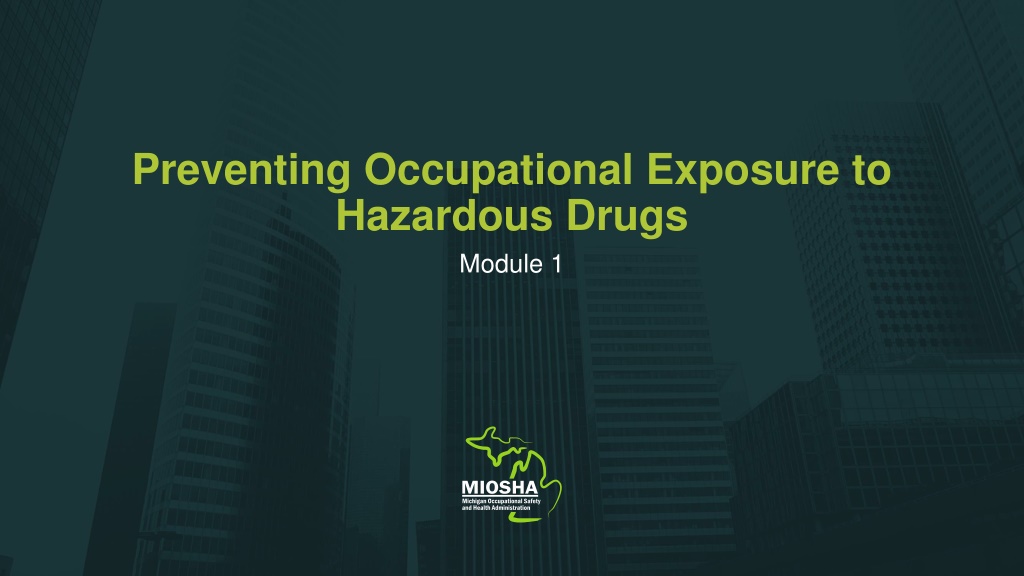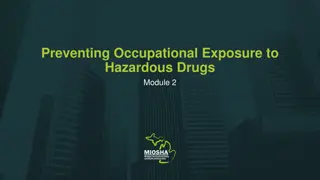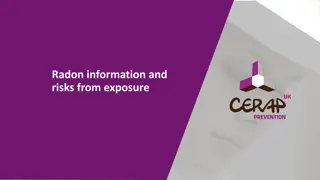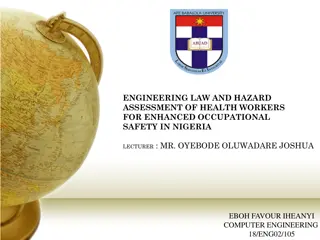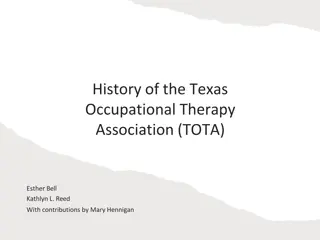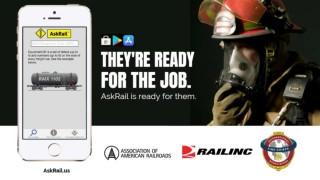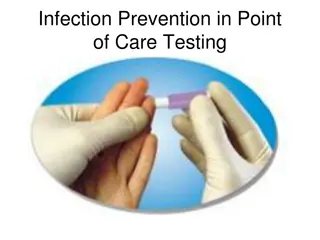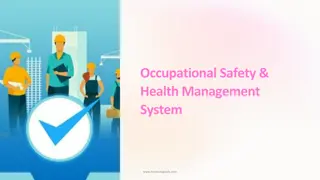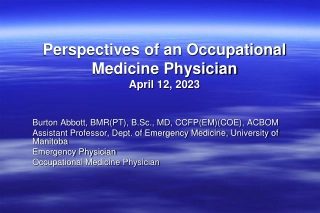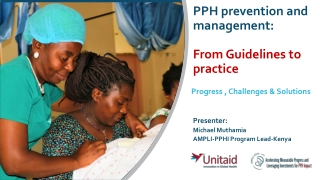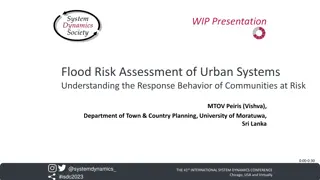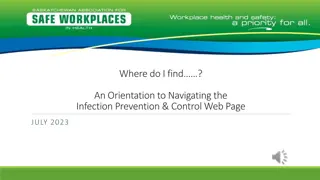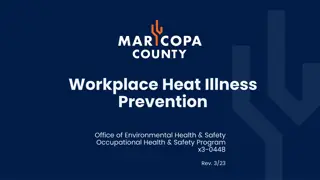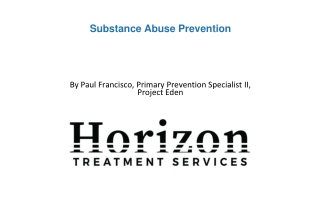Occupational Exposure to Hazardous Drugs: Risks and Prevention
Learn about the hazards of exposure to hazardous drugs, including potential health risks such as cancer, nausea, reproductive toxicity, and organ damage. Explore training modules, drug categories, and a list of hazardous drugs to ensure workplace safety. Discover NIOSH criteria for identifying hazardous drugs and the known carcinogens in the healthcare setting. Protect yourself and others from the dangers of handling hazardous medications with valuable insights and resources provided by the Michigan Department of Labor and Economic Opportunity.
Download Presentation
Please find below an Image/Link to download the presentation.
The content on the website is provided AS IS for your information and personal use only. It may not be sold, licensed, or shared on other websites without obtaining consent from the author. Download presentation by click this link. If you encounter any issues during the download, it is possible that the publisher has removed the file from their server.
Presentation Transcript
Preventing Occupational Exposure to Hazardous Drugs Module 1
Hazardous drug categories Module 1 Training Overview Specific hazards of drugs Employees at risk Applicable MIOSHA standards Resources 2 Michigan Department of Labor and Economic Opportunity
Hazardous Drugs Anti-neoplastic medications Anti-viral drugs Hormones Bioengineered drugs 3 Michigan Department of Labor and Economic Opportunity
List of Hazardous Drugs NIOSH ALERT - Preventing Occupational Exposures to Antineoplastic and Other Hazardous Drugs in Health Care Settings (cdc.gov) Carcinogenicity Teratogenicity or other developmental toxicity Reproductive toxicity Organ toxicity at low doses Genotoxicity Structure and toxicity profiles of new drugs that mimic existing drugs determined hazardous by the above criteria 4 4 Michigan Department of Labor and Economic Opportunity
NIOSH List of Hazardous Drug Table 1: Antineoplastic drugs Table 2: Non-antineoplastic that meet one or more of the NIOSH criteria for a hazardous drug Table 3: Drugs that primarily pose a reproductive risk to men and women who are actively trying to conceive and women who are pregnant or breastfeeding 5 Michigan Department of Labor and Economic Opportunity
What are the Hazards of Exposure? Hazardous drugs may cause the following: Cancer Nausea Developmental or reproductive toxicity Rashes Hair loss Genotoxicity: Chromosome five or seven changes Harm to organs: Hearing loss Liver Kidney 6 Michigan Department of Labor and Economic Opportunity
Hazardous Drugs That Are Carcinogens Probable Carcinogens Azacitidine Carmustine Cisplatin Doxorubicin Lomustine Nitrogen Mustard Procarbazine Teniposide Possible Carcinogens Amsacrine Bleomycin Dacarbazine Daunorubicin Mitomycin Mitoxantrone Streptozocin Known Carcinogens Arsenic trioxide Azothiaprine Busulfan Chlorambucil Cyclophosphamide Etoposide Melphalan Semustine Tamoxifen Thiotepa Treosulfan MOPP* ECB* *Combination regimens International Agency for Research on Cancer (IARC) 7 7 Michigan Department of Labor and Economic Opportunity
Who is at Risk? Pharmacy staff Nursing staff Physicians Medical assistants Operating room staff Veterinary care workers Research staff in laboratories Environmental service workers Shipping and receiving personnel Others 8 8 Michigan Department of Labor and Economic Opportunity
Potential Routes of Exposure Dermal absorption: Ingestion via contaminated: Direct drug contact Food, gum Contact with contaminated surfaces Hand-to-mouth transfer Inhalation: Contact contaminated body fluids Aerosols Injection: Vapors Sharps Breakage 9 Michigan Department of Labor and Economic Opportunity
Exposure Opportunities: Drug Preparation Unpacking/stocking hazardous drugs Handling drug vials Breaking open ampoules Reconstituting/mixing drugs Pressure build-up in vials Transferring drugs from one container to another Needle sticks Crushing oral forms 10 10 Michigan Department of Labor and Economic Opportunity
Exposure Opportunities: Drug Administration Injected drugs Intracavitary drugs Aerosols from purging air Poor fitting connections Splashing Oral drugs Needle-sticks Intravenous infusions Broken tablets / capsules Crushing tablets / opening capsules Spilling liquid forms Spiking into a drug-filled bag Leaks from prime tubing Loose connections Needle-sticks Un-spiking 11 Michigan Department of Labor and Economic Opportunity
Exposure Opportunities: Drug Disposal Handling contaminated materials Used IV equipment Residual drug Used personal protective equipment Carrying drug waste from administration site to disposal site Reaching into waste containers Using wrong containers Over-full containers 12 12 Michigan Department of Labor and Economic Opportunity
Exposure Opportunities: Contaminated Excretions Variable Hazardous Drug (HD) excretion: hours to days (48 hours average) Handling body fluids of patients who have received HDs Urinals/urine Bedpans/stool Emesis basins/emesis Flushing toilets Linen contaminated with bodily fluids 13 13 Michigan Department of Labor and Economic Opportunity
Applicable MIOSHA Regulations Hazard Communication - MIOSHA Part 92/430 Personal Protective Equipment - MIOSHA Part 33/433 Respiratory Protection - MIOSHA Part 451 Bloodborne Infectious Diseases - MIOSHA Part 554 Housekeeping MIOSHA Part 1 Sanitation MIOSHA Part 474 Recordkeeping MIOSHA Part 11 14 14 Michigan Department of Labor and Economic Opportunity
MIOSHA Part 92/430 Hazard Communication Requires manufacturers and employers to provide chemical safety and health information to employees: Written Program Chemical Inventory (list of chemicals) Multi-employer worksites Non-routine Tasks Labeling Safety Data Sheets (SDS) Training * List of Hazardous Drugs reviewed annually, and annual documented effective training competency is required by U.S. Pharmacopeial Convention (USP) <800> 15
Safety Data Sheets (SDS) Maintain SDS for all hazardous chemicals Examples: Hazardous drugs (liquid or powdered) Disinfectants Oxygen Consumer products exemptions: Personal use items (i.e., hairspray, aspirin) Other household products used for purpose and quantity intended in the home. Contact manufacturer/distributor/supplier when required SDS not received. 16 16 Michigan Department of Labor and Economic Opportunity
Safety Data Sheets (SDS) Section 1 Identification Section 2 Hazard(s) identification Section 3 Composition/Ingredients Section 4 First-aid Measures Section 5 Fire-fighting Measures Section 6 Accidental Release Measures Section 7 Handling and Storage Section 8 Exposure Controls / PPE Section 9 Physical and Chemical Properties Section 10 Stability and Reactivity Section 11 Toxicological Information Section 12 Ecological Information* Section 13 Disposal Consideration* Section 14 Transport Information* Section 15 Regulatory Information* Section 16 Other information including date of preparation of last revision *Sections outside of MIOSHA jurisdiction but inclusion of these sections is necessary for a GHS compliant SDS 17 Michigan Department of Labor and Economic Opportunity
MIOSHA Part 33/433 Personal Protective Equipment (PPE) MIOSHA Parts 33 and 433: Perform a Job Hazard Assessment (JHA) Certification of hazard assessment Employee training Clean and sanitize multi-user PPE 18 Michigan Department of Labor and Economic Opportunity
PPE HAZARD ASSESSMENT An employer shall: Assess the workplace to determine hazards present. Select PPE needed and required to perform the job. Communicate selection decision to employees. Written certification of PPE assessment including: Workplace evaluated, Person who certified assessment, Date of hazard assessment completion. 19 19 Michigan Department of Labor and Economic Opportunity
PPE Hazard Assessment Elements Workstation/job category Hazard source Body part affected Is PPE required Type of PPE required 20 20 Michigan Department of Labor and Economic Opportunity
Example of Assessment Form 21 Michigan Department of Labor and Economic Opportunity
EXAMPLEOF ASSESSMENT FORM 22 22 Michigan Department of Labor and Economic Opportunity
PPE TRAINING REQUIREMENTS Employer shall provide training to each employee who is required use PPE: When PPE is necessary. What PPE is necessary. How to: Put it on (don) Take it off (doff) Adjust, and wear PPE 23 23 Michigan Department of Labor and Economic Opportunity
MIOSHA Part 451 Respiratory Protection 24 Michigan Department of Labor and Economic Opportunity
MIOSHA Part 451 Respiratory Protection Employer must evaluate exposure and determine if respiratory protection is required. Examples: Aerosolization of hazardous drugs ribavirin, pentamidine, others Preparing outside a biological safety cabinet- fluorouracil, cyclophosphamide, crushing tablets/dust Spill response 25 25 Michigan Department of Labor and Economic Opportunity
Selecting the Appropriate Respirator All must be NIOSH Certified. The type selected depends on the task and form of the drug. Surgical mask: not appropriate; not a respirator N-95: for particulates, but not for vapors or splash Surgical N-95: for particulates and splash, but not for vapors Half-mask with a multi-gas cartridge and P100-filter: unpacking HDs that are not contained in plastic (USP 800 requirement) Full-facepiece chemical cartridge-type respirator: for large spills or while compounding where vapor protection is needed Powered air purifying respirator: for large spills or while compounding 26 26 Michigan Department of Labor and Economic Opportunity
MIOSHA Part 451 Respiratory Protection Employer Responsibilities For required use of a respirator, the employer must: Supply required respirators at no cost to the employees Maintain a written program by a program administrator Provide training: Use Limitations Proper care, maintenance and disposal Medical evaluation Fit testing complete initially then annually thereafter 27 27 Michigan Department of Labor and Economic Opportunity
Types of Respirators Full face air purifying w/HEPA filter Surgical N-95 w/fluid protection Powered air purifying respirator (PAPR) 28 28 Michigan Department of Labor and Economic Opportunity
Evaluation of Respiratory Protection Is this a respirator? 2. Is this proper use? 1. 29 Michigan Department of Labor and Economic Opportunity
MIOSHA Part 554 Bloodborne Infectious Diseases 30 Michigan Department of Labor and Economic Opportunity
MIOSHA Part 554 Bloodborne Infectious Diseases Applies where reasonable anticipation of occupational exposure to blood or other potentially infectious materials. Needle stick with needle contaminated only with hazardous drugs are not covered by Bloodborne standard. Bloodborne standard engineering and work practices controls could be implemented to reduce exposure to hazardous drugs. 31 31 Michigan Department of Labor and Economic Opportunity
Bloodborne Exposure Control Plan Related Provisions Exposure determination Summary of the training program Procedures for evaluating exposure incidents Task-specific Standard Operating procedures (SOPs) to include: Employee recognition of exposure Personal Protective Equipment (PPE) selection, use, maintenance, and disposal Contingency plans Task-specific SOPs for management of inadvertent exposures such as needlesticks 32 32 Michigan Department of Labor and Economic Opportunity
Waste Disposal Containers or bags that are: Closable Leakproof Color-coded or labeled For contaminated sharps all the above plus puncture-resistant 33 33 Michigan Department of Labor and Economic Opportunity
MIOSHA Part 1 General Provisions and Part 474 Sanitation General Provisions Housekeeping: Materials shall be placed in a container in a manner that does not create a hazard to an employee. All places of employment, aisles, passageways, storerooms, and service rooms shall be kept clean and orderly. Sanitation - Food and beverages: No employee shall be allowed to consume food or beverages in any area exposed to a toxic material. Food or beverages shall not be stored in an area exposed to a toxic material. 34 34 Michigan Department of Labor and Economic Opportunity
MIOSHA Part 11 Recording and Reporting Occupational Injuries and Illnesses 35 Michigan Department of Labor and Economic Opportunity
Who Must Keep MIOSHA Records? Employers with more than ten employees during the previous calendar year. Employers selected to participate in the mandatory Bureau of Labor Statistics (BLS) annual survey. Partially Exempt employers: Employer with ten or less employees during the previous calendar year. Employers in designated North American Industry Classification System (NAICS) codes. 36 36 Michigan Department of Labor and Economic Opportunity
Partially Exempt Healthcare Industrial Codes 6211 Offices of Physicians 6212 Offices of Dentists 6213 Offices of Other Health Practitioners 6214 Outpatient Care Centers 6215 Medical and Diagnostic Laboratories 37 37 Michigan Department of Labor and Economic Opportunity
Partially Exempt must report when: When requested to record/report by the Bureau of Labor Statistics (BLS) Any workplace incident that results in: Fatality In-patient hospitalization Amputation Loss of an eye 38 38 Michigan Department of Labor and Economic Opportunity
Expanded Reporting Requirements All covered employers must reportthe following: Within 8 hours: any work-related fatality Within 24 hours: Work-related in-patient hospitalizations of one or more employees Work-related amputations Work-related losses of an eye 39 39 Michigan Department of Labor and Economic Opportunity
Occupational Disease Reporting Employee information Employer information Illness and comments information Report submitted to the State (see MIOSHA website) 4040
MIOSHA Resources: Standards and Compliance Part 92 and 430 Hazard Communication Part 431 Hazardous Work in Laboratories Part 33 and Part 433 Personal Protective Equipment Part 451 Respiratory Protection Part 474 Sanitation Part 554 Bloodborne Infectious Diseases Recording and Reporting of Occupational Injuries and Illnesses 41 41 Michigan Department of Labor and Economic Opportunity
Questions? Michigan Occupational Safety and Health Administration (MIOSHA) Consultation, Education and Training (CET) Division MIOSHA/ CET Main Line: 517-284-7720 Michigan.gov/MIOSHA
